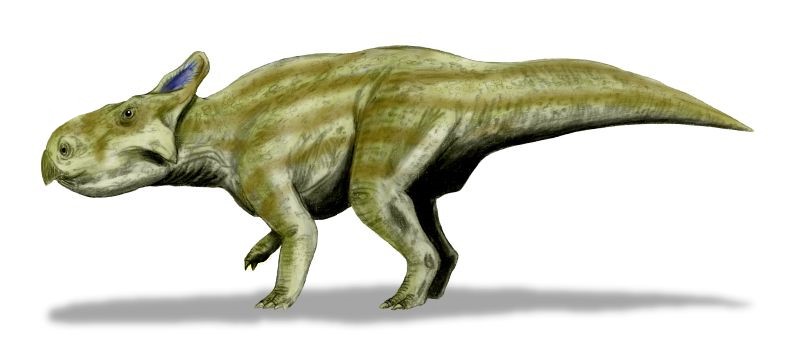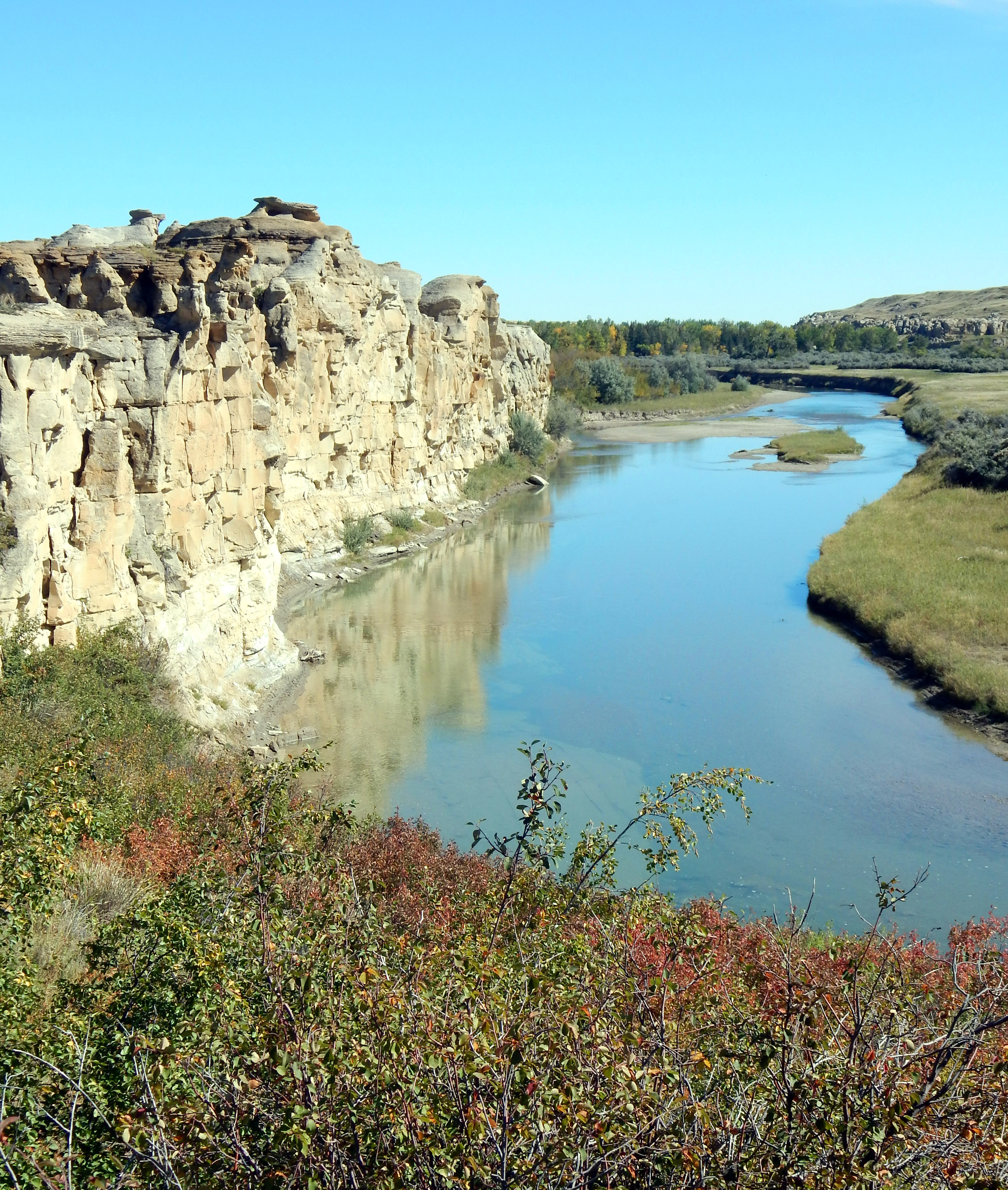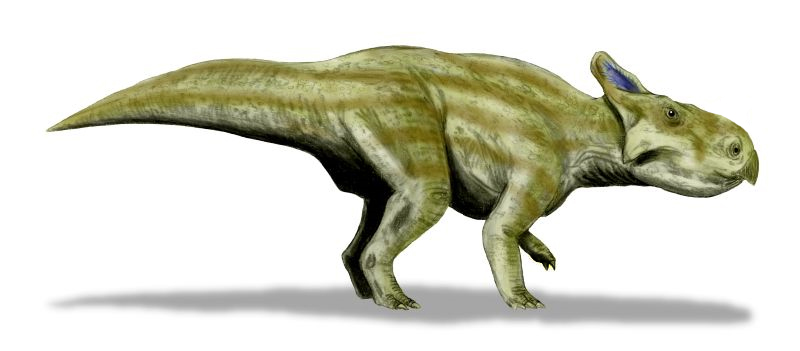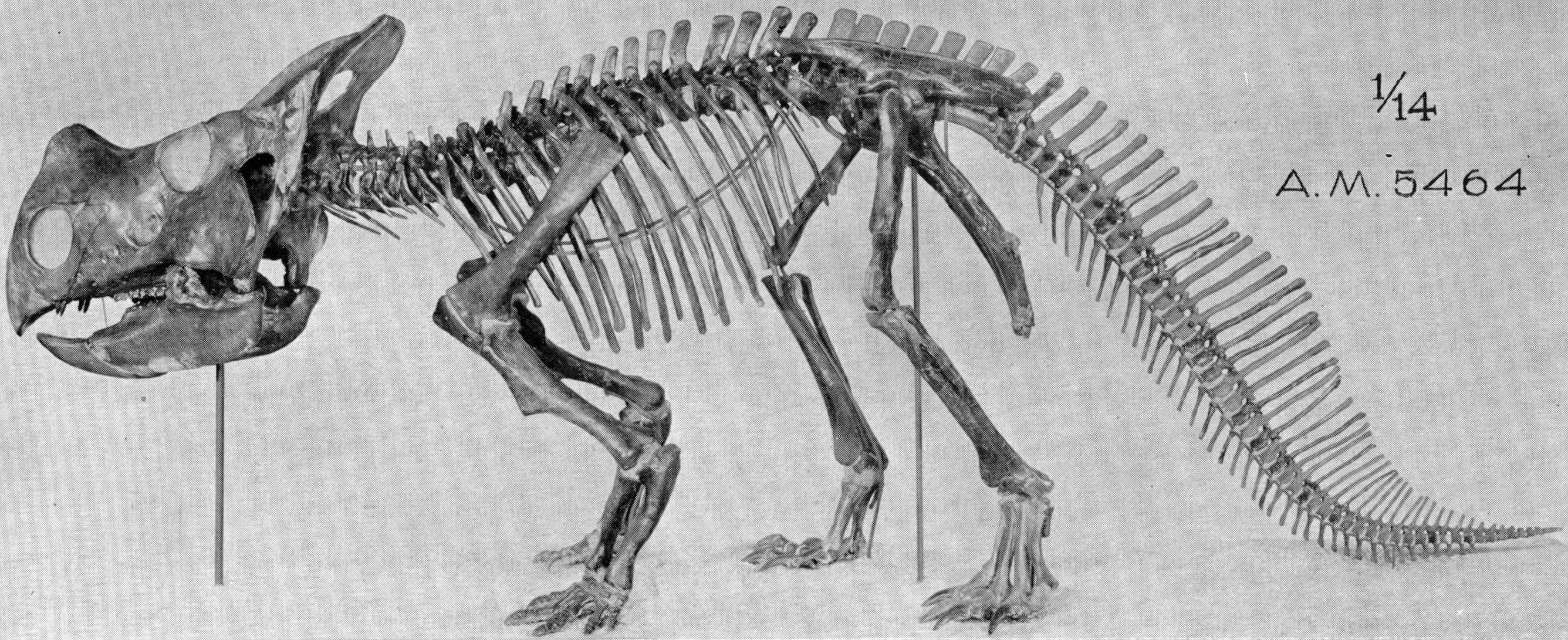|
Gryphoceratops
''Gryphoceratops'' is an extinct genus of leptoceratopsid ceratopsian dinosaur known from the Late Cretaceous of Alberta, southern Canada. Discovery ''Gryphoceratops'' is known only from the holotype ROM 56635, a partial right dentary. The holotype was collected in the northwest corner of Dinosaur Provincial Park, from bonebed 55 of the Milk River Formation, dating to the late Santonian stage of the middle Late Cretaceous period, about 83.5 million years ago. Thus, ''Gryphoceratops'' represents the oldest known leptoceratopsid. However, a cladistic analysis found it to be one of the most advanced leptoceratopsids. Additionally, the holotype probably represents the smallest adult ceratopsian known from North America. The cladogram below represents the cladistic relationship of ''Gryphoceratops'' compared to other leptoceratopsids. Etymology ''Gryphoceratops'' was first named by Michael J. Ryan, David C. Evans, Philip J. Currie, Caleb M. Brown and Don Brinkman in ... [...More Info...] [...Related Items...] OR: [Wikipedia] [Google] [Baidu] |
Leptoceratopsids
Leptoceratopsidae is an extinct family of neoceratopsian dinosaurs from Asia, North America and Europe. Leptoceratopsids resembled, and were closely related to, other neoceratopsians, such as the families Protoceratopsidae and Ceratopsidae, but they were more primitive and generally smaller. Phylogeny Leptoceratopsidae was originally named by Franz Nopcsa von Felső-Szilvás in 1923 as a subfamily Leptoceratopsinae, and its type species is '' Leptoceratops gracilis''. Mackovicky, in 2001, defined it as a stem-based taxon and a family consisting of ''Leptoceratops gracilis'' and all species closer to ''Leptoceratops'' than to ''Triceratops horridus''.Makovicky, P.J. 2001. A ''Montanoceratops cerorhynchus'' (Dinosauria: Ceratopsia) braincase from the Horseshoe Canyon Formation of Alberta, In: Tanke, D.H. & Carpenter, K. (Eds.). ''Mesozoic Vertebrate Life''. Bloomington: Indiana University Press. Pp. 243-262. The cladogram below follows the topologies from a 2015 analysis by Yim ... [...More Info...] [...Related Items...] OR: [Wikipedia] [Google] [Baidu] |
Leptoceratopsid
Leptoceratopsidae is an extinct family of neoceratopsian dinosaurs from Asia, North America and Europe. Leptoceratopsids resembled, and were closely related to, other neoceratopsians, such as the families Protoceratopsidae and Ceratopsidae, but they were more primitive and generally smaller. Phylogeny Leptoceratopsidae was originally named by Franz Nopcsa von Felső-Szilvás in 1923 as a subfamily Leptoceratopsinae, and its type species is ''Leptoceratops gracilis''. Mackovicky, in 2001, defined it as a stem-based taxon and a family consisting of ''Leptoceratops gracilis'' and all species closer to ''Leptoceratops'' than to ''Triceratops horridus''.Makovicky, P.J. 2001. A ''Montanoceratops cerorhynchus'' (Dinosauria: Ceratopsia) braincase from the Horseshoe Canyon Formation of Alberta, In: Tanke, D.H. & Carpenter, K. (Eds.). ''Mesozoic Vertebrate Life''. Bloomington: Indiana University Press. Pp. 243-262. The cladogram below follows the topologies from a 2015 analysis by Yiming ... [...More Info...] [...Related Items...] OR: [Wikipedia] [Google] [Baidu] |
Ischioceratops Flipped
''Ischioceratops'' () is an extinct genus of small herbivorous ceratopsian dinosaur that lived approximately 69 million years ago during the latter part of the Cretaceous Period in what is now China. ''Ischioceratops'' was a small sized, moderately-built, ground-dwelling, quadrupedal herbivore, whose total body length has been estimated to be about . The ceratopsians were a group of dinosaurs with parrot-like beaks which fed on vegetation and thrived in North America and Asia during the Cretaceous Period, which ended approximately 66 million years ago, at which point they all became extinct. Its name means "ischium horned face", referring to the peculiar shape of the ischiatic bones. ''Ischioceratops'' existed in the Wangshi Group during the late Cretaceous. It lived alongside centrosaurines, saurolophines, and tyrannosaurines. The most common creatures in the formation were '' Sinoceratops'' and '' Zhuchengtyrannus''. Discovery and naming In 2015, the type species ''Isc ... [...More Info...] [...Related Items...] OR: [Wikipedia] [Google] [Baidu] |
Milk River Formation
The Milk River Formation is a sandstone-dominated stratigraphic unit of the Western Canada Sedimentary Basin in southern Alberta, Canada. It was deposited in near-shore to coastal environments during Late Cretaceous (late Santonian to early Campanian) time. Based on uranium-lead dating, palynology and stratigraphic relationships, deposition occurred between ~84.1 and 83.6 Ma. The sandstones of the Virgelle Member in the centre of the formation are well-exposed at Writing-on-Stone Provincial Park in southwestern Alberta, where they bear petroglyphs carved into them by First Nations people. The formation is fossiliferous and has yielded an extensive vertebrate fauna (see Tables below), as well as fossil ammonites. In some areas it hosts shallow natural gas reservoirs.Payenberg, T.D.H., Braman, D.R. and Miall, A.D. 2003. Depositional environments and stratigraphic architecture of the Late Cretaceous and Eagle formations, southern Alberta and north-central Montana: Relationships to ... [...More Info...] [...Related Items...] OR: [Wikipedia] [Google] [Baidu] |
Montanoceratops
''Montanoceratops'' is an extinct genus of small ceratopsian dinosaur that lived approximately 70 million years ago during the latter part of the Cretaceous Period in what is now Montana and Alberta. ''Montanoceratops'' was a small sized, moderately-built, ground-dwelling, quadrupedal herbivore, that could grow up to an estimated in length and in body mass. Description ''Montanoceratops'' was a typical primitive ceratopsian in many respects, distinguished from the later species by the presence of claws, rather than hooves, and by having teeth in its upper jaw, rather than a toothless beak. It was once thought to have a horn on its nose but that was a misplaced cheek horn.Holtz, Thomas R. Jr. (2008) ''Dinosaurs: The Most Complete, Up-to-Date Encyclopedia for Dinosaur Lovers of All Ages'Supplementary Information/ref> According to Brown and Schlaikjer (1935), ''Montanoceratops'' can be distinguished based on the following characteristics: * the nasal bone is proportionally l ... [...More Info...] [...Related Items...] OR: [Wikipedia] [Google] [Baidu] |
Ceratopsian
Ceratopsia or Ceratopia ( or ; Greek: "horned faces") is a group of herbivorous, beaked dinosaurs that thrived in what are now North America, Europe, and Asia, during the Cretaceous Period, although ancestral forms lived earlier, in the Jurassic. The earliest known ceratopsian, '' Yinlong downsi'', lived between 161.2 and 155.7 million years ago.Holtz, Thomas R. Jr. (2011) ''Dinosaurs: The Most Complete, Up-to-Date Encyclopedia for Dinosaur Lovers of All Ages,'Winter 2010 Appendix./ref> The last ceratopsian species, '' Triceratops prorsus'', became extinct during the Cretaceous–Paleogene extinction event, . ''Triceratops'' is by far the best-known ceratopsian to the general public. It is traditional for ceratopsian genus names to end in "''-ceratops''", although this is not always the case. One of the first named genera was ''Ceratops'' itself, which lent its name to the group, although it is considered a ''nomen dubium'' today as its fossil remains have no distinguishing char ... [...More Info...] [...Related Items...] OR: [Wikipedia] [Google] [Baidu] |
Montanoceratops BW Flipped
''Montanoceratops'' is an extinct genus of small ceratopsian dinosaur that lived approximately 70 million years ago during the latter part of the Cretaceous Period in what is now Montana and Alberta. ''Montanoceratops'' was a small sized, moderately-built, ground-dwelling, quadrupedal herbivore, that could grow up to an estimated in length and in body mass. Description ''Montanoceratops'' was a typical primitive ceratopsian in many respects, distinguished from the later species by the presence of claws, rather than hooves, and by having teeth in its upper jaw, rather than a toothless beak. It was once thought to have a horn on its nose but that was a misplaced cheek horn.Holtz, Thomas R. Jr. (2008) ''Dinosaurs: The Most Complete, Up-to-Date Encyclopedia for Dinosaur Lovers of All Ages'Supplementary Information/ref> According to Brown and Schlaikjer (1935), ''Montanoceratops'' can be distinguished based on the following characteristics: * the nasal bone is proportionally la ... [...More Info...] [...Related Items...] OR: [Wikipedia] [Google] [Baidu] |
Ischioceratops
''Ischioceratops'' () is an extinct genus of small herbivorous ceratopsian dinosaur that lived approximately 69 million years ago during the latter part of the Cretaceous The Cretaceous ( ) is a geological period that lasted from about 145 to 66 million years ago (Mya). It is the third and final period of the Mesozoic Era, as well as the longest. At around 79 million years, it is the longest geological period of ... Period (geology), Period in what is now China. ''Ischioceratops'' was a small sized, moderately-built, ground-dwelling, quadrupedal herbivore, whose total body length has been estimated to be about . The ceratopsians were a group of dinosaurs with parrot-like beaks which fed on vegetation and thrived in North America and Asia during the Cretaceous Period, which ended approximately 66 million years ago, at which point they all became extinct. Its name means "ischium horned face", referring to the peculiar shape of the ischium, ischiatic bones. ''Ischioceratops' ... [...More Info...] [...Related Items...] OR: [Wikipedia] [Google] [Baidu] |
Asiaceratops
''Asiaceratops'' (meaning "Asian horned face") is a genus of herbivorous ceratopsian dinosaur. It lived during the Early-Late Cretaceous. The type species, ''A. salsopaludalis'' is known from Uzbekistan, while ''A. sulcidens'' is known from China and Mongolia. Discovery and naming The type species, ''Asiaceratops salsopaludalis'', was formally described by Lev Nesov, L.F. Kaznyshkina and Gennadiy Olegovich Cherepanov in 1989. The generic name combines a reference to Asia with ''~ceratops'', "horned face". The specific name means "of the salt marsh" in Latin. In the same publication '' Microceratops sulcidens'' Bohlin 1953 was renamed into a second species of ''Asiaceratops'': ''Asiaceratops sulcidens''.L.A. Nessov, L F. Kaznyshkina, and G.O. Cherepanov. (1989). esozoic ceratopsian dinosaurs and crocodiles of central Asia In: Bogdanova and Khozatskii (eds.), ''Theoretical and Applied Aspects of Modern Palaeontology'' pp 144-154 The holotype of ''Asiaceratops salsopaludalis'', ... [...More Info...] [...Related Items...] OR: [Wikipedia] [Google] [Baidu] |
Late Cretaceous
The Late Cretaceous (100.5–66 Ma) is the younger of two epochs into which the Cretaceous Period is divided in the geologic time scale. Rock strata from this epoch form the Upper Cretaceous Series. The Cretaceous is named after ''creta'', the Latin word for the white limestone known as chalk. The chalk of northern France and the white cliffs of south-eastern England date from the Cretaceous Period. Climate During the Late Cretaceous, the climate was warmer than present, although throughout the period a cooling trend is evident. The tropics became restricted to equatorial regions and northern latitudes experienced markedly more seasonal climatic conditions. Geography Due to plate tectonics, the Americas were gradually moving westward, causing the Atlantic Ocean to expand. The Western Interior Seaway divided North America into eastern and western halves; Appalachia and Laramidia. India maintained a northward course towards Asia. In the Southern Hemisphere, Australia a ... [...More Info...] [...Related Items...] OR: [Wikipedia] [Google] [Baidu] |
Prenoceratops
''Prenoceratops'', (meaning 'bent or prone-horned face' and derived from Greek ''prene-/πρηνη-'' meaning 'bent forwards' or 'prone', ''cerat-/κερατ-'' meaning 'horn' and ''-ops/ωψ'' meaning 'face') is a genus of ceratopsian dinosaur from the Late Cretaceous Period. It was a relatively small dinosaur, reaching in length and in body mass. Its fossils have been found in the upper Two Medicine Formation in the present-day U.S. state of Montana, in Campanian age rock layers that have been dated to 74.3 million years ago.Ryan, M. J., Evans, D. C., Currie, P. J., Brown, C. M., & Brinkman, D. (2012). New leptoceratopsids from the Upper Cretaceous of Alberta, Canada. ''Cretaceous Research'', 35: 69-80. Fossils were also found in the Oldman Formation in the modern day Canadian province of Alberta, dating to around 77 million years ago. Discovery and species ''Prenoceratops'' was first discovered on a Blackfeet reservation in Pondera County, Montana in layers coming from t ... [...More Info...] [...Related Items...] OR: [Wikipedia] [Google] [Baidu] |
Cladistic
Cladistics (; ) is an approach to biological classification in which organisms are categorized in groups (" clades") based on hypotheses of most recent common ancestry. The evidence for hypothesized relationships is typically shared derived characteristics (synapomorphies'')'' that are not present in more distant groups and ancestors. However, from an empirical perspective, common ancestors are inferences based on a cladistic hypothesis of relationships of taxa whose character states can be observed. Theoretically, a last common ancestor and all its descendants constitute a (minimal) clade. Importantly, all descendants stay in their overarching ancestral clade. For example, if the terms ''worms'' or ''fishes'' were used within a ''strict'' cladistic framework, these terms would include humans. Many of these terms are normally used paraphyletically, outside of cladistics, e.g. as a ' grade', which are fruitless to precisely delineate, especially when including extinct species. ... [...More Info...] [...Related Items...] OR: [Wikipedia] [Google] [Baidu] |








